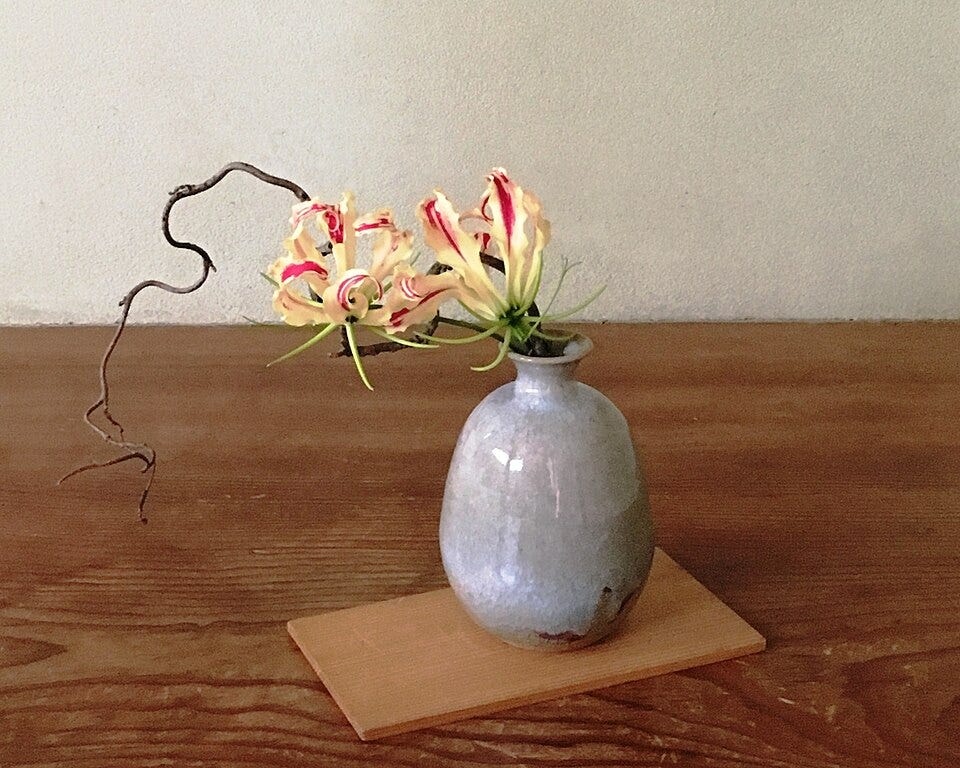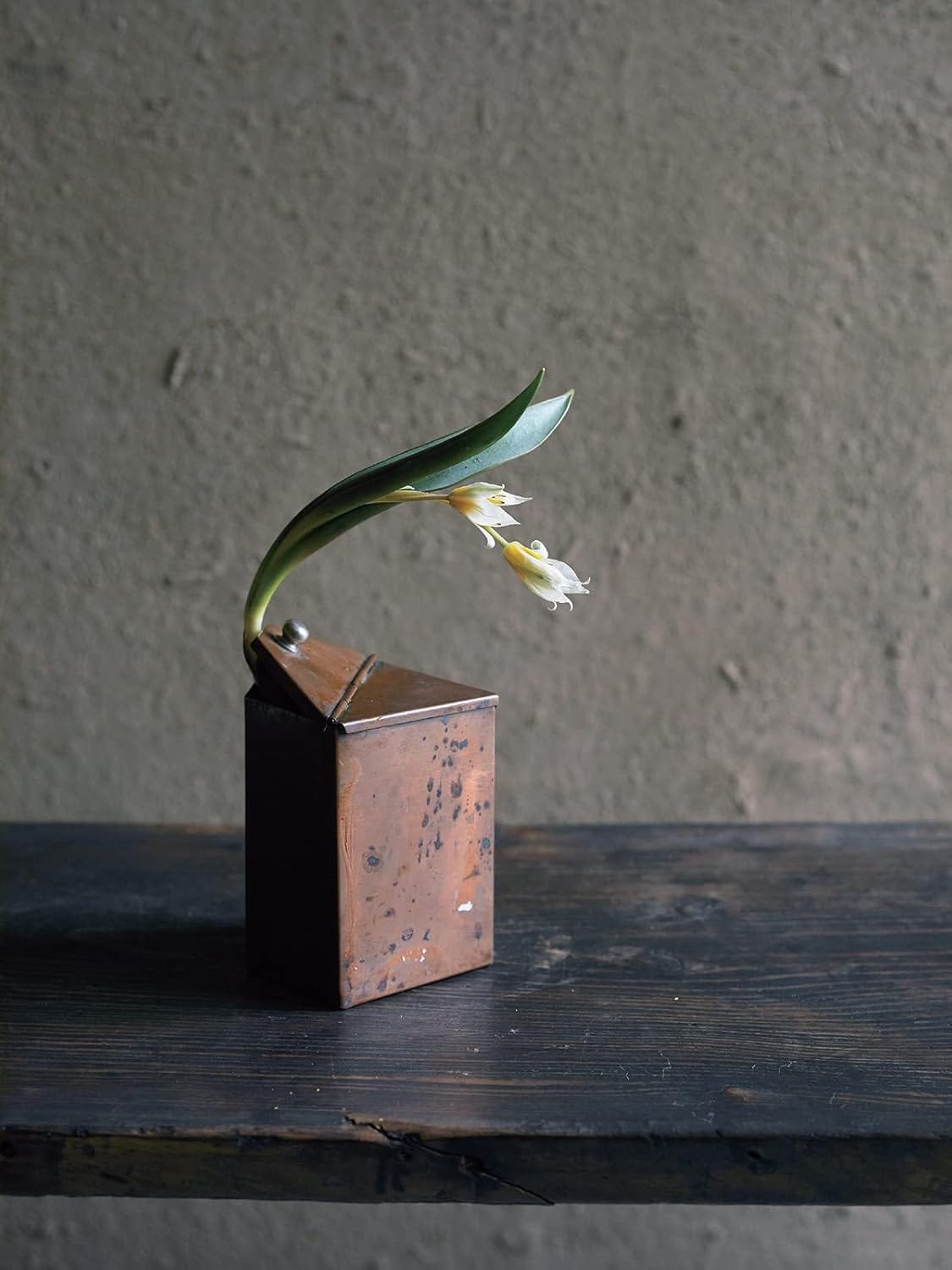Ikebana: why simple communication is so hard
The Japanese practice of ikebana is the floral embodiment of deliberate communication. It's an easy point to miss

Flowers, like jewelry or fine art, are one of those things that you indulge in because they are useless.1 Their uselessness is what gives them value. A deliberate and sparse aesthetic is a counter-act to the crushing dullness of the utilitarian, and the milquetoast appeal of the abundant. Plastic flowers in cheap restaurants are tacky. 200 fresh Teleflora bouquets at a wedding are sufficiently nice, and completely forgettable. A single black tulip in a cracked earthenware bowl is either poetry, or utterly ridiculous, depending on who you ask. The same could be said of a Rothko.
In Ikebana: The Zen Way of Flowers by Yuji Ueno, I found passages such as these2:
“Get rid of preconceived notions toward vessels and flowers and face them using only beauty and authenticity as decision points. Apart from that, it’s important to just take things as they come.” (“Decision work”, Ikebana: The Zen Way of Flowers, p 162)
This arrangement (p. 57) - a wild tulip “escaping” from a firepan - gave me pause:
Hanaike3 that take into account the direction from which light enters make people feel comfortable. This is because they follow the natural order of things. (p. 46)
Ikebana can seem “simple” or “minimalist” if interpreted through a certain narrow lens, but I’d argue that practised correctly it is staggeringly more sophisticated than any commercial floral practice that we’d consider “normal” in the Western world. Ikebana accounts for the complex reality of things. When expressing a clear message in the middle of such complexity, it is necessary to focus.
The use of a wild tulip variety is a value-laden choice. Against the historical backdrop of tulip domestication, and the hubris of the 1630s Dutch tulip bubble, the work is practically an act of economic subversion: a thrash against the human desire to control and sell nature. The use of a fire-pan bucks expectation: it’s a vessel usually filled with ash, a material associated with death. The flower “escapes” from the shade-facing lid of the fire pan, much as weeds escape from cracks in asphalt. It turns stubbornly towards the light, and even has the flippancy to bloom.
The work is a story unto itself, and a single extraneous character - another leaf, another flower - would muddle the tale. To call ikebana “simple” is to miss this point entirely. The aim is not to be minimalist for the sake of being minimalist. The aim is to communicate clearly, and to say something compelling.4 When every plant and object is so laden with complexity, you can only use so many if you wish to keep the message coherent.
As anyone who attempts any form of creative work knows, achieving this type of compelling simplicity is one of the hardest things in the world when done in earnest. It’s all the more impressive, then, to see it done well.
Week 10 (of my bid to write one essay a week, for the rest of the year. Apologies for falling off the wagon as of late, but excuses aren’t very interesting - so we carry on.)
The same could be said of writing on a blog like this: it is a luxury to allocate time away from all that you could be doing to further a career, building something you can sell, or creating a monetizable “brand” in order to simply think. In that sense it is one of the few remaining forms of agency in the world that cannot be bought or sold. I suspect that is why luxury items appeal to us at all, and why they always need to maintain an air of being above commodities, of somehow being representative of a higher art: their worth is their complete lack of utilitarian value.
Other passages that struck me, even though “all they do” is state simple truths:
“…some are facing out to the side and some are downcast. When I encounter flowers such as these, I wonder what their lives were like before they ended up here, waiting to be purchased. The form and size of plants are influenced by their environment. Whether they’ve been grown in a place with strong winds or have once been stepped on, it’s these plants that have grown up adapting to a harsh environment that I find appealing…” (“Being Interesting”, Ikebana: The Zen Way of Flowers, p 161)
On Yuji Ueno’s use of the term hanaike as distinct from “floral arrangement”:
I began to use the term “hanaike” (flower arranging) experimentally about fifteen years ago […] This word did not originally mean “the act of arranging flowers.” In the world of ikebana, it was used as another name for “vase.” […] works of all kinds were being subsumed by the contemporary English term “floral arrangements,” which was inconsistent with the image I was trying to convey. (Ikebana: The Zen Way of Flowers, p 9)
As a chuckle, I’d like to contrast this with the take on ikebana that I found in Flowers by Design by Ingrid Carozzi:
I can’t say enough good things about this ancient approach that is making a big comeback. Not only is it a fun and relatively easy way to arrange flowers, it is also a very cost-effective way to bring some floral beauty to your home. (p 150)
While it’s always nice to see a commercially successful artist make a nod to an underrated art form, the framing of ikebana as easy and cost-effective (“it’s cheap and easy when you’re only using one flower!”) is a funny crossing of wires. It’s a great example of how philosophies get lost in translation when they are ported from one market / culture to another.


